| Published
on 25
Aug 2023 |
All rights reserved.
|
|
|
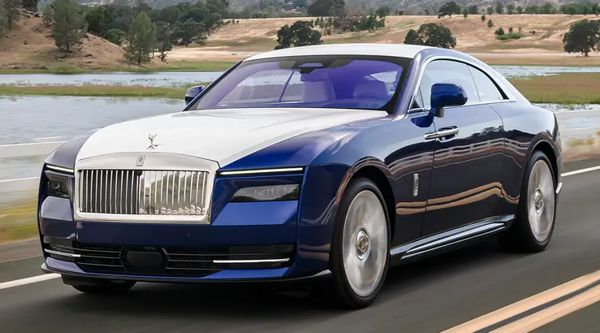 |
|
Electric
propulsion will be a perfect match with Rolls-Royce...
|
|
Charles Rolls imported an
electric car from America in 1898, impressed by its noiseless,
vibrationless and clean operation, but he saw the range and charging
problems would take many years to overcome, so he eventually opted to
partner with Henry Royce and founded Rolls-Royce in 1904. Almost 120
years later, Rolls-Royce finally has built its first electric car,
Spectre.
The Spectre won’t be alone. All the new Rolls-Royce models
launched from now on will be pure electric, and by 2030 the Goodwood
factory will no
longer build any combustion-engined cars, sadly. Rolls-Royce has always
been famous for impeccable refinement, especially the smoothness and
quietness of its inline-6, V8 or V12 engines. Electric propulsion is
even smoother and quieter, so it will be a perfect match with the
brand. However, if all electric cars are smooth and quiet, then what
will separate Rolls-Royce from, say, a Hyundai or Toyota? That is a
question the Spectre must answer.
Rolls-Royce said its latest 2-door coupe is the successor of the once
range-topping Phantom Coupe,
but I remember that car was larger and
rarer still. Put it in the context of the ever growing size of modern
luxury cars, I would say it is more like the successor of Wraith.
However, that doesn’t stop Rolls-Royce from charging more. Priced at a
whopping £330,000, yet many customers will undoubtedly push that
to half a million pounds after options and customization, the Spectre
will be nearly as expensive as the flagship Phantom. As rare? No, with
a waiting list surpassing 18 months, Rolls-Royce expects to build as
many as 2500 cars in the first year of production alone. Good business.
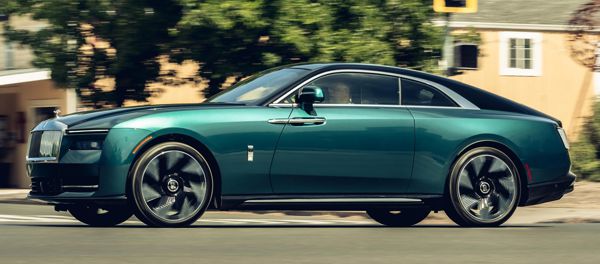 |
|
Make
no mistake, the Spectre is not a GT or 2+2 coupe but a 2-door luxury
sedan.
|
|
Despite losing 2 doors and some accommodation, the Spectre is almost as
large as other Rolls-Royces. Its measures nearly 5.5 meters from nose
to tail, its wheelbase spans 3.2 meters and its shoulders are set over
2 meters apart, not to mention a crossover-like height of 1573 mm, so
it is unquestionably a huge car. This reflects on scale immediately:
2890 kilograms ! That’s 280 kg heftier than a Phantom EWB and a full
400 kg heavier than a Ghost. Admittedly, 700 kg of which is attributed
to the battery pack.
Surprisingly, the electric coupe sits on the same aluminum spaceframe
platform as its combustion-powered stablemates, as its design is quite
flexible. The battery pack, with a net capacity of 102 kWh, comes from
BMW i7. It is put in the floorpan and contributes to chassis strength.
Rolls-Royce claims the chassis’ torsional rigidity is 30 percent higher
than that of the Ghost, which is already good for 40,000 Nm/degree. So
much so that it can skip the upper wishbone dampers that are standard
on Ghost. The big battery pack also doubles as noise insulation,
keeping the cabin free of road noise.
The Spectre’s exterior design is probably the best we have seen since
BMW revived the brand at Goodwood. It keeps the imposing front end,
which includes a prominent and upright grille, but employs slimmer
headlights, a high but slightly curvy waistline and a fastback-style
roofline. The lower roof and shallower windows contribute the sense of
coupe. The huge, 23-inch optional wheels (22-inch items are standard)
fill its side area fuller and lessen its bulky perception. In short,
this big coupe looks imposing yet graceful.
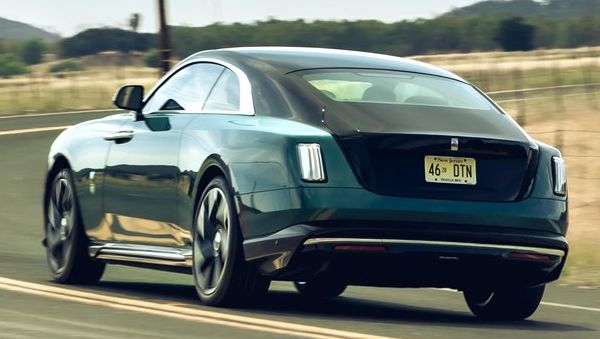 |
|
There
are no drive modes to select, just one and only one mode: Comfort.
|
|
Aerodynamics is
also surprisingly good. Thanks to sealing most of the front radiator
grille, the use of flat underbody and even a Spirit of Ecstasy statue
that is both collapsible and reshaped for less drag, the Spectre
returns a drag coefficient of merely 0.25, unimaginable for
Rolls-Royce, unimaginable for a car so big.
The electric motors also come from BMW i7. A smaller one up front and a
larger at the rear axle combined to produce 585 horsepower and 664
pound-foot of torque, incidentally the same as the V12 power of
Phantom. For sure it could be made more powerful, but the emphasis of
Spectre, just like any Rolls, is not performance but how gracefully it
puts performance in use, so top speed is a word “Adequate” and 0-60 mph
is achieved in 4.4 seconds. Rolls-Royce knows very well that its
customers own
multiple cars beside yachts and private jets. If they want to have
thrills, they will drive their Ferraris or
Bugattis or Porsches. Why bother about Tesla-like acceleration on a
Rolls-Royce?
The same can be said to its range and charging capability. If they want
to
go longer distances, they will drive a Phantom or Range Rover or
whatever conventionally powered, definitely not a luxury 2-door
electric coupe. Therefore, a WLTP range of 530 km (329 miles) is
considered sufficient. BMW’s 195kW DC charge rate is not exactly state
of the art, but Rolls-Royce buyers can always afford to install their
own fast chargers at home, so it doesn’t matter 10-80 percent charge
taking 34 minutes, or whatever time. Good point.
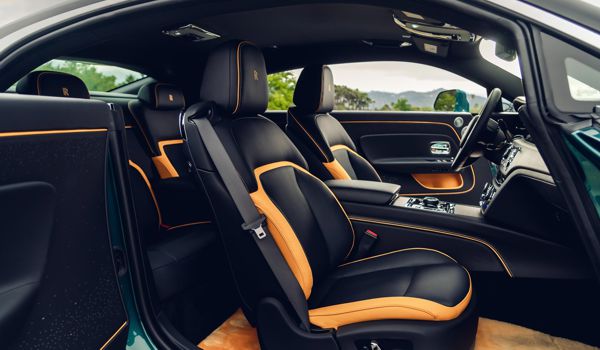 |
|
Quietness
is beyond the approach of any cars currently on sale, its ICE-powered
siblings included.
|
|
The first
thing you notice when getting on board is the lack of surprise – it
feels every bit like a traditional Rolls-Royce indeed. Yes, this car
has two big doors opened in suicide way, unlike anything else on the
market, but so was the Phantom Coupe, Drophead Coupe and Wraith that
ran before it. The difference is now the doors are power-operated and
have electric soft closing. And yes, you still get a nice umbrella pops
out from each door.
You sit a bit higher than in the Phantom Coupe – 20mm higher up front
and 30mm higher at the rear – but that doesn’t make a huge difference
because the Rolls-Royce sitting experience has always been like
crossovers. The shallower greenhouse does feel more coupe-like, but the
lack
of B-pillars avoids claustrophobic feel at the rear bench. Well, it’s
not
a bench but 2 individual seats separated by a transmission tunnel whose
function is questionable. Considering how huge this car is, it is not
surprising to find the rear seats can accommodate 6-footers with good
head and leg room. Even though the fastback roof appears to limit rear
headroom, it is not, just like any 1573mm-tall crossovers should not.
Make no mistake, the Spectre is not a 2+2 coupe but a 2-door
luxury sedan.
Packaging-wise, its only shortfall is luggage space. While the tail
looks long, it accommodates only 380 liters of luggage, yet 50 of which
is under the boot floor and supposed to store charging cables. What
about the “frunt” up front? As an electric car, the Spectre doesn’t
need that huge “engine compartment” and long long bonnet, does it? So
open the bonnet, you will be shocked to see a plastic panel pretending
to be an engine cover. What’s underneath? Who knows? I suspect
Rolls-Royce deliberately wastes that space in order to make its first
electric car like a traditional Rolls-Royce. It could have fitted a
trunk there or shortened the nose, but why should it risk its
traditional image when no customers would take the Spectre to long
journeys?
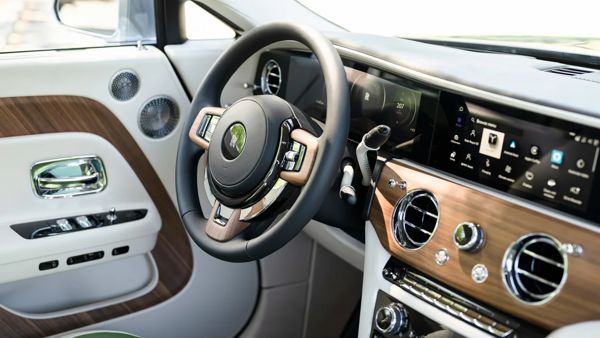 |
|
No
huge touchscreen standing in the way, just good old familiar switches,
classy wood, billet aluminum, swathes of fine leather and “Starlight”
roofliner...
|
|
Sitting on the vast and comfortable driver chair,
surrounding you is a traditional environment. The dashboard, console
and transmission tunnel are all taken from the Ghost. No huge
touchscreen standing in the way, just good old familiar switches,
classy wood, billet aluminum, swathes of fine leather and “Starlight”
roofliner – now extended to optional door panels. The infotainment
system is reskinned from BMW’s iDrive, including its rotary controller.
It is easy to navigate.
The Spectre drives very much like traditional Rolls-Royce, too. Its
large steering wheel is light in effort but precise and offers some
feel. There are no drive modes to select, just one and only one mode:
Comfort. No matter powertrain or suspension, every department is tuned
for comfort in the first place. The acceleration is smooth and linear,
skipping the on-off switch like throttle response that other EVs so
excited to show off. Its brake pedal has a long travel for linear
action, but it blends regenerative braking and mechanical braking
seamlessly. The suspension is always comfort first. There are active
anti-roll bars to keep cornering tidy, and 4-wheel steering to enhance
agility in slow corner, but it won’t pretend to be a sports sedan. Push
it harder and you will feel the brakes struggling to cope with its
nearly 3 tons of weight. On straight, the anti-roll bars decouple
automatically and the air suspension softens as the car detects the
road ahead. This is when the Spectre floats and you can feel its body
control quite loose.
With the biggest 23-inch wheels fitted, the air suspension might
struggle to absorb sharp low-speed bumps, which is probably the biggest
weakness of the car. Otherwise, the Spectre rides smoothly. Cruising
refinement is outstanding. In particular, quietness is beyond the
approach of any cars currently on sale, its ICE-powered siblings
included. Exactly because EVs make so little powertrain noises, their
wind and road noises become all the more noticeable. Only Rolls-Royce
has taken note of this characteristic and puts some 170kg of
sound-deadening materials to isolate the Spectre’s cabin from all sorts
of noises. As a result, it feels significantly quieter than other
Rolls-Royce in high-speed cruising. Hopefully measurement data will
prove that when the car is taken to full road test.
Some low-speed ride issues aside, the Spectre is every bit a
Rolls-Royce is expected to be, and probably more desirable than you
might have expected. The transition to electric power might hurt some
legacy car makers, but Rolls-Royce and its customers will be happy to
see that happening.
|
Verdict:     |
|